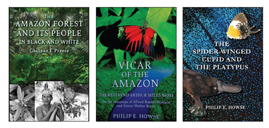James Crowden highlights three new illustrated books from local authors

The Amazon matters more than you might think. Global warming, plant diversity, carbon dioxide, rising sea levels. By good fortune the Dorset coast has several eminent scientists and two of them have used lockdown to produce not one but three illustrated books with an Amazonian flavour.
First is Sir Ghillean Prance of Lyme Regis who has written The Amazon Forest and its People with his own black and white photographs many of which were taken over 40 years ago. Sir Ghillean has made 39 expeditions to Amazonia collecting over 350 new species of plants. He has worked at the New York Botanical gardens and was Director of the Botanical Gardens at Kew 1988-1999. He is an expert on Brazil nuts.
This book touches on anthropology, botany, trees, body painting, cassava, hallucinogenic initiation, plant hunting, basket making, fishing, conservation and forest survival. Often it is the indigenous people who suffer from exploitation both direct and indirect, yet they are key to the forest’s very survival. This is an important book which charts the life of seven tribes including the Yanomami. Our future hinges on their survival and that of the Amazon. This book has a human quality which brings the forests of Amazonia alive.
The second eminent scientist is Professor Philip Howse of Burton Bradstock who worked for many years on insect behaviour at Southampton University. He has now produced two books. The first about an eccentric butterfly collecting clergyman called Vicar of the Amazon all about the Rev Arthur Miles Moss who built the first Anglican church in the Amazon in 1912. He had a vast parish, the largest in the world which comprised one twenty fourth of the world’s surface. He was better known for his butterfly collecting and he amassed a collection of over 25,000 butterflies which are now resident in the British Museum.
The book charts the adventures of Miles Moss who came from the Lake District and then went via Cambridge to Norwich, Switzerland, Lima and Peru before finally settling in Belem in Brazil. Gateway to the Amazon river. His life story has many narrow escapes and is well illustrated by colour photographs of the butterflies he encountered. Miles Moss also collected local songs and beliefs. He was well aware of the dark side of how indigenous people were treated by the rubber barons. Miles Moss encountered bandits and strange Colonels in the Brazilian army. He kept many notebooks and was an accomplished watercolourist.
Third, and by no means least, is a well illustrated volume called The Spider-winged Cupid and the Platypus also by Philip Howse. This book is a voyage into mimicry and shows how extraordinary nature really is at camouflage and outwitting the enemy. ie predators both large and small. Spiders, moths, butterflies, snakes, bats, birds, fish, frogs, tigers, apes and scorpions. Let alone the duck billed platypus which had Darwin foxed. At the Natural History museum back in the 1790s when the experts were sent a skin from Australia, they thought the Platypus was a hoax: part beaver, part mole, part duck. Yet nature has its own complex way of surviving. Hence the Spider winged cupid butterfly from the Amazon which flies along the forest floor and looks as if a spider is attacking it to ward off other spiders. Deception and mimicry are all important. Not just in warfare.
Professor Howse’s book contains a myriad of other parallel conundrums which are the product of skilled artistic evolution. The message seems to be ‘the odder you look the better chance you have of surviving’
All three books are published by Butterflies and Amazonia and are initially available from their website www.butterfliesandamazonia.com. Price £29.99 signed and £24.99 unsigned. P&P extra.
NB This AMAZONIA website is not to be confused with the other giant sales device known as AMAZON which mimics a rainforest.




